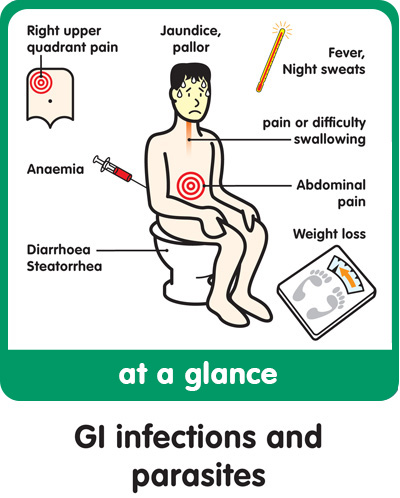Parasites

Parasites can be broadly classified as either protozoa (such as Giardia and Cryptosporidium), worms (such as nematodes and cestodes), and flukes.
You may think that parasitic infections of the gut only happen to people who travel in far off places, but over the last few years we have seen several outbreaks in the UK and the USA. There are few statistics that highlight the extent of this as a problem in the UK but researchers in the Center for Disease Control in America found parasites in 20% of routine stool specimens.
Most parasite infections affect the bowel, where mild IBS type symptoms occur. Parasites can contribute to a wide array of systemic health problems, especially chronic digestive disorders, arthritis, chronic fatigue, muscle weakness, as well as problems with memory, anxiety and depression, enlarged lymph glands, night sweats and occasional fever.
A parasite is an organism within you that lives off your body. In acute cases the person is alerted to an immediate problem by watery diarrhoea, intestinal cramps, fever and fatigue. But often a parasite problem goes undetected for years. Vague gastrointestinal symptoms, allergic and immune problems and chronic fatigue can all be caused by parasitic infection. The main culprits are Giardia, Cryptosporidium, Entamoeba hystolica and Blastocystis hominis. Cryptosporidium is seen more and more in city water because chlorine does not kill it.
Giardia lamblia infection is common throughout the world, and again is transmitted through the faecal-oral route. Organisms multiply in the jejunum, attaching themselves to the gut wall by way of sucking disks. Consequent cytotoxicity and gut wall permeability produce diarrhoea. This type of infection is characterised by weight loss, crampy abdominal pain, gut grumbling (borborygmi) and wind, as well as bulky offensive stools. There may be associated lactose intolerance or fat malabsorption. Patients with poor levels of secretory IgA may be subject to recurrent bouts.
Cryptosporidium parvum is a zoonotic coccidian parasite transmitted by milk, water and direct contact with farm animals. Person to person spread can occur with intimate contact. It may interfere with the glucose stimulated sodium pump in the small intestine, leading to fluid secretion. Symptoms are usually watery diarrhoea with abdominal cramps.
Entamoeba hystolica infects the large intestine. It is transmitted by the faecal-oral route, and in food and water. Once ingested, the organisms to the gut wall and produce an epithelial cytotoxin, amoebapore.Symptoms include frequent, small volume bloody stools, with an offensive odour.
Many clinical ecologists accept that as many as one in six people in the UK may be carrying around Giardia, which causes severe fatigue and bowel disturbance, and perhaps as many as 10% of the population have Cryptosporidium infestation.
Parasites can damage the body in several ways:
They secrete toxins which challenge the immune system; they can produce allergic-type reactions;
They cause pain and inflammation.
Giardia lamblia is an important cause of Traveller’s diarrhoea and chronic fatigue. Patients who think they have IBS or food allergy can often date the onset of their symptoms to a holiday abroad.
Gut helminths:
Infection with roundworms and hookworms is prevalent in developing countries. Roundworms are acquired by ingesting the eggs, whilst hookworms larvae invade through intact skin. These parasites cause disease by competing for nutrients, and severity of disease is related to the number of organisms in the body. Hookworm infection is worse because the worms take blood, leading to anaemia. Infection can be asymptomatic, and diagnosis is by stool sample, where the eggs are identified. Usual treatment is with imidazoles.
Threadworms live in the large intestine; the females migrate to the anus where they lay their eggs on the perianla skin. Symptoms are more common in children, but often the whole family is infected. Threadlike worms can be seen in the faeces. The patient may complain of perianal itching, often worse at night. Scratching allows contamination of the fingernails with larvae containg eggs, which when placed in the mouth start the whole cycle again. Diagnosis is simple, attaching some sticky tape to the perianal area usually identifies D shaped eggs on th tape. Usual treatment is with mebendazole.
Tapeworms are usually ingested from infected pork or beef. The worms compete for nutrients, and patients are usually asymptomatic. Diagnosis is by egg identification in a stool sample. Treatment is with praziquantel.
In the coming years, we may find that our recognition of parasites may parallel that of candidiasis – neglecting it for years before recognising how fundamentally it affects health.
In order to eliminate parasites it is essential to identify which specific parasites are present. The best way to do this is by means of a parasitology test in the form of a stool sample, which will also give a susceptibility profile. This profile tests the specific parasite with a range of pharmaceutical and natural products to see which is the most effective at killing it. This means that you can avoid a blind ‘shotgun’ approach, where you take a product in the hope that it might be effective.